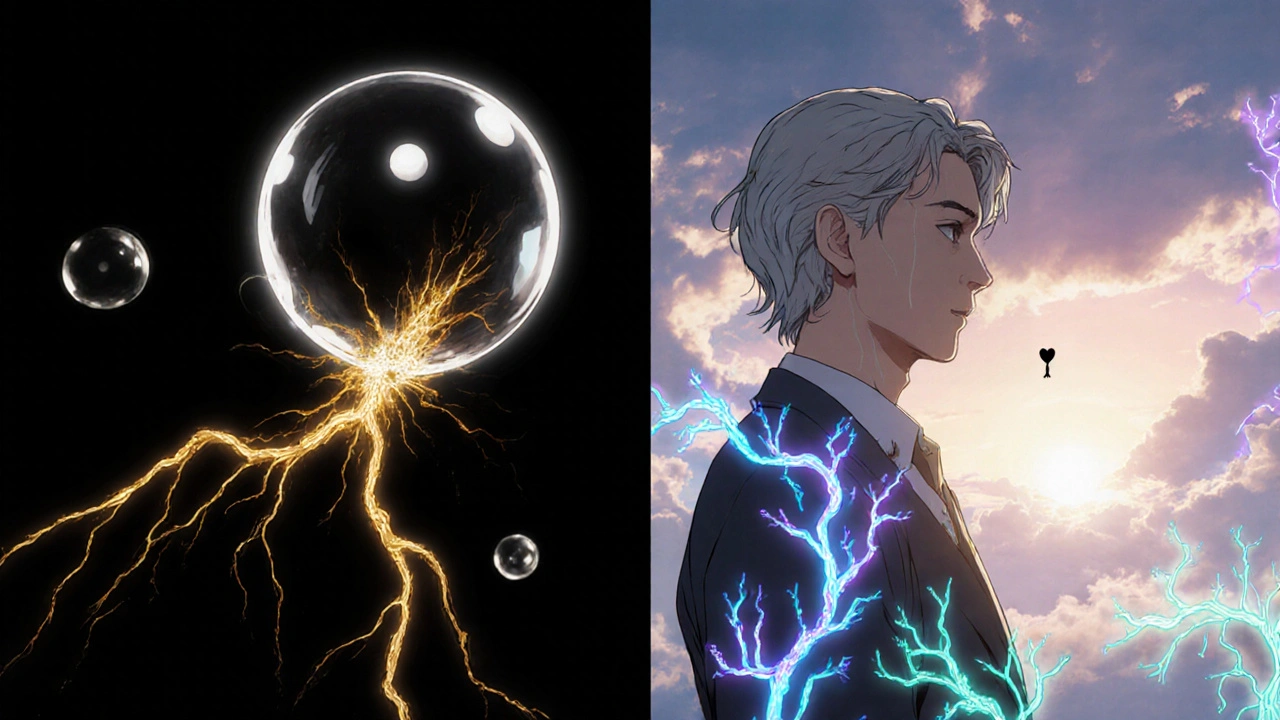When Glaucoma Medications Aren’t Enough
If you’ve been told your eye pressure won’t stay low enough with drops or laser, surgery might be the next step. Glaucoma doesn’t cause pain, but it quietly damages your optic nerve - and once vision is lost, it’s gone for good. Surgery doesn’t cure glaucoma, but it can stop or slow the damage by lowering pressure inside the eye. Two main types of surgery are used today: trabeculectomy and MIGS (Minimally Invasive Glaucoma Surgery). Each has different goals, risks, and recovery times.
Trabeculectomy: The Long-Standing Gold Standard
Trabeculectomy has been around since the 1960s and is still the most effective surgery for lowering eye pressure in advanced glaucoma. The procedure creates a tiny channel under the white part of the eye (sclera), allowing fluid to drain out and form a small blister-like pocket (called a bleb) under the eyelid. This bleb acts like a pressure relief valve.
On average, trabeculectomy lowers eye pressure by 40-60%. Most patients end up with pressures between 5 and 15 mmHg - low enough to protect vision in severe cases. About 85-90% of patients reach their target pressure within the first year, according to data from Mass Eye and Ear in 2023.
But there’s a catch. The surgery takes about an hour, and recovery is slow. You’ll need weekly check-ups for the first few months. The bleb can leak, get infected, or scar over. About 10-15% of people have a leak in the first few weeks. Long-term, 10-20% of blebs fail within five years. There’s also a small but serious risk of infection inside the eye (endophthalmitis), which happens in about 0.5-2% of cases.
Because of these risks, trabeculectomy isn’t the first choice anymore - it’s reserved for when other treatments fail. It’s often used for younger patients who need lifelong pressure control, or for those with advanced nerve damage.
MIGS: Smaller Incisions, Faster Recovery
MIGS procedures changed the game. They started appearing around 2012, and today, they make up about 65% of all standalone glaucoma surgeries in the U.S. These surgeries use tiny devices - smaller than a grain of rice - inserted through a micro-incision (less than 1.5mm). Many are done at the same time as cataract surgery, so you’re not having two separate operations.
Popular MIGS options include:
- iStent inject: Two tiny stents placed in the eye’s natural drainage system. Lowers pressure by 20-30%.
- Hydrus Microstent: A small metal scaffold that opens up the drainage channel. Works well with cataract surgery.
- Xen Gel Stent: A soft, 6mm tube that drains fluid to the surface. More effective than iStent but costs more.
- GATT (Gonioscopy-Assisted Transluminal Trabeculotomy): A thread is threaded through the drainage system to open it up. Can lower pressure by 30-35%.
MIGS doesn’t lower pressure as much as trabeculectomy - usually to 15-18 mmHg. But that’s often enough for mild to moderate glaucoma. Most patients reduce their eye drops by 1.5 to 2 medications after surgery.
The big advantage? Safety. Complication rates are under 5%, and most people see clearly within 1-2 weeks. No bleb means no risk of infection from a leak. You can go back to normal activities faster. There’s no need for frequent post-op visits - usually just 1-2 months of monitoring.

What About Laser? SLT Is Still First
Before surgery, most doctors try Selective Laser Trabeculoplasty (SLT). It’s quick, painless, and takes less than 10 minutes. SLT uses a laser to stimulate the eye’s drainage system without damaging tissue. It’s not surgery, but it’s often the first step.
The 2023 LiGHT trial showed SLT works just as well as daily eye drops for controlling pressure over three years. About 75% of patients stayed at target pressure without needing more treatment. That’s why most guidelines now say SLT should come before drops, not after.
There’s even a newer version called DSLT (Direct Selective Laser Trabeculoplasty), which treats the whole drainage angle automatically without touching the eye. It’s promising, but it can cause more temporary irritation and doesn’t lower pressure quite as much as traditional SLT.
Comparing Trabeculectomy and MIGS Side by Side
| Feature | Trabeculectomy | MIGS |
|---|---|---|
| Typical IOP Reduction | 40-60% (down to 5-15 mmHg) | 20-30% (down to 15-18 mmHg) |
| Surgery Time | 60 minutes | 10-20 minutes |
| Recovery Time | 4-6 weeks | 1-2 weeks |
| Post-Op Visits | 3-6 months | 1-2 months |
| Complication Rate | 5-15% | 1-3% |
| Bleb Formation | Yes | No |
| Best For | Advanced glaucoma, young patients | Mild-to-moderate glaucoma, cataract patients |
| Average Cost (per eye) | $4,200 | $5,000-$6,300 |
Costs vary by region and insurance, but MIGS devices are often more expensive than the materials used in trabeculectomy. That’s why some insurers still prefer trabeculectomy for advanced cases - it’s cheaper long-term.

Who Gets Which Surgery?
There’s no one-size-fits-all answer. Your surgeon will look at:
- How advanced is your glaucoma? If your vision is already fading, you likely need trabeculectomy. If you’re just starting to lose peripheral vision, MIGS may be enough.
- What’s your target pressure? If you need pressure below 15 mmHg, trabeculectomy is more likely to get you there.
- Are you having cataract surgery? MIGS fits right into that procedure - no extra incisions needed.
- How well can you follow up? Trabeculectomy needs lots of visits. If you live far from the clinic or have trouble getting time off, MIGS is easier to manage.
- Age and life expectancy? Younger patients may benefit from trabeculectomy because they need decades of pressure control. Older patients often prefer MIGS for safety and speed.
Many surgeons now use a stepwise approach: SLT first, then MIGS if pressure creeps up, and trabeculectomy only if those fail. This shift is backed by the 2025 update to the American Academy of Ophthalmology’s guidelines.
What’s Next for Glaucoma Surgery?
The field is changing fast. New devices are being tested in the suprachoroidal space - that’s the area behind the eye’s drainage system. These could offer better pressure control than MIGS without the risks of trabeculectomy.
Long-term data on MIGS is still limited because the procedures are so new. But early results are encouraging. Most patients stay stable for 3-5 years. As more data comes in, MIGS may replace trabeculectomy for many cases - especially if costs come down.
For now, the best approach is personalized. If you’ve been told you need surgery, ask: “What’s my target pressure? Why this surgery over another? What happens if it doesn’t work?” You’re not just choosing a procedure - you’re choosing a long-term plan to protect your vision.
Is glaucoma surgery painful?
No. Both trabeculectomy and MIGS are done under local anesthesia, so you won’t feel pain during the procedure. You might feel pressure or a slight tugging sensation, but not sharp pain. Afterward, most people report mild discomfort - like having something in their eye - that fades within a few days.
Can I stop my eye drops after surgery?
Maybe - but not always. MIGS often reduces the number of drops you need by 1-2, but you may still need to use some. Trabeculectomy can sometimes eliminate the need for drops entirely, but not for everyone. Your surgeon will monitor your pressure and adjust your medication plan over time.
How long does the effect of glaucoma surgery last?
Trabeculectomy can last 10-15 years or longer if the bleb stays healthy. MIGS results typically last 3-5 years, though some patients stay stable longer. If pressure rises again, you can often have another MIGS, try SLT, or go back to trabeculectomy. It’s not a one-time fix - it’s part of a long-term plan.
Can I drive after glaucoma surgery?
Most people can drive again within 1-2 weeks after MIGS, as long as their vision is clear and they’re not on strong pain meds. After trabeculectomy, it may take 3-4 weeks because vision can be blurry during healing. Always check with your surgeon before getting behind the wheel.
What if the surgery doesn’t work?
If pressure stays too high, you may need another procedure. For MIGS, options include a second MIGS device, SLT, or trabeculectomy. For trabeculectomy, a bleb needling (a minor office procedure to unblock the drainage) or a tube shunt may be needed. Surgery isn’t always permanent, but there are usually other options.
Next Steps: What to Do If You’re Considering Surgery
Don’t rush. Talk to your ophthalmologist about:
- Your current eye pressure and how much it’s changed over the last year.
- How much vision loss you’ve had - and how fast it’s progressing.
- Whether you’re planning cataract surgery soon.
- Your ability to attend follow-up visits.
- Your goals: Do you want to stop drops? Avoid long-term risks? Maximize pressure control?
Ask for a copy of your latest visual field test and optic nerve scan. These help determine how urgent your situation is. If your pressure is stable and your vision hasn’t changed much, you might not need surgery right away - SLT or a change in drops could be enough.
Glaucoma moves slowly. But when it comes to surgery, the timing matters. Waiting too long can mean losing vision you can’t get back. Choosing the right procedure - and the right time - gives you the best shot at keeping your sight for life.

Henrik Stacke
November 21, 2025 AT 14:14Trabeculectomy’s bleb complications are no joke-I had a friend who developed a late-onset endophthalmitis six months post-op. It took three vitrectomies and nearly lost his vision. MIGS isn’t perfect, but the safety profile? Night and day.
Jennifer Skolney
November 22, 2025 AT 15:11I’m a nurse in a retina clinic and I’ve seen so many patients terrified of surgery-then relieved when they realize MIGS is basically a lunchtime procedure. No more ‘I can’t go to work for a month’ panic. It’s a game-changer for working parents and shift workers.
Suzan Wanjiru
November 24, 2025 AT 15:03SLT first is now standard of care-why start with drops that cost $300/month and cause red eyes and stinging? SLT is $500 one-time, no side effects, and works as well as drops for 3+ years. If your doc hasn’t mentioned it, ask why.
Charmaine Barcelon
November 25, 2025 AT 06:52People don’t realize MIGS is just a marketing buzzword. It’s not better-it’s just cheaper for hospitals. Trabeculectomy still saves vision longer. Stop being fooled by fancy devices.
Javier Rain
November 27, 2025 AT 00:56If you’re over 65 and have mild glaucoma? Go MIGS. You’re not going to live long enough to need a 15-year solution. Save yourself the bleb drama and the 6-month follow-up schedule. Life’s too short.
Manjistha Roy
November 27, 2025 AT 11:05My mother had trabeculectomy in 2018-her bleb scarred down by 2021, and she needed a needling procedure. Now she’s on a new MIGS device after cataract surgery. The difference in recovery? From ‘I couldn’t bend over’ to ‘I was gardening in 10 days.’ It’s not magic-it’s progress.
Kane Ren
November 28, 2025 AT 06:24Just had MIGS with cataract surgery last week-no drops for 3 days, vision clear by day 2, and I’m back at the gym. No more 6 am eye drop routines. I’m never going back.
Kezia Katherine Lewis
November 30, 2025 AT 06:20As a clinical researcher, I’ve reviewed 12 RCTs on MIGS outcomes. The 3-year data shows consistent IOP reduction in 78% of mild-moderate cases, with complication rates under 2.5%. The real limitation isn’t efficacy-it’s device cost and payer reimbursement. That’s why trabeculectomy persists in public health systems.
Dalton Adams
November 30, 2025 AT 23:34Anyone who says MIGS is ‘good enough’ hasn’t seen a real glaucoma patient with 30% optic nerve damage. Trabeculectomy is the only thing that drops pressure below 12 mmHg reliably. MIGS is for people who don’t want to face reality. And yes, I’ve done 200+ of both.
JD Mette
December 2, 2025 AT 11:06I’m 58 and was told I needed trabeculectomy. I got a second opinion and went with Xen. My pressure went from 28 to 14. No bleb, no pain, no drama. I’m just glad I didn’t rush into the big surgery. Sometimes less is more.
Pramod Kumar
December 4, 2025 AT 08:51My uncle in Delhi had a trabeculectomy and now he’s blind in that eye because of infection. He didn’t have access to follow-up care. MIGS isn’t just safer-it’s more equitable. In places where people can’t afford monthly checkups, this isn’t luxury-it’s survival.
Jennifer Shannon
December 5, 2025 AT 04:18It’s fascinating how medicine has shifted from ‘do the most aggressive thing possible’ to ‘do the least invasive thing that works.’ Glaucoma surgery is a perfect example: we used to think bigger was better, but now we know that preserving quality of life-sleep, work, travel, peace of mind-is just as important as the number on the tonometer.
Olanrewaju Jeph
December 7, 2025 AT 02:38For those considering surgery: always request your visual field report and OCT scan before making a decision. Don’t let fear or convenience drive your choice. Your optic nerve doesn’t lie. If your nerve is thinning, MIGS may not be enough. If your pressure is stable and your field is intact, SLT + MIGS is a smart, conservative path.
Karla Morales
December 8, 2025 AT 22:53Let’s be real: MIGS is expensive because it’s a device-driven profit center. Trabeculectomy is cheap because it’s a surgical skill. But the data doesn’t lie-MIGS has fewer complications. So who’s really benefiting? The patient? Or the device manufacturer? 🤔
Lisa Lee
December 9, 2025 AT 07:14Why are Americans so obsessed with ‘minimally invasive’? In Canada, we just do the surgery that works. Trabeculectomy lasts. MIGS is a Band-Aid for people who can’t handle the truth. We don’t need fancy gadgets-we need results.